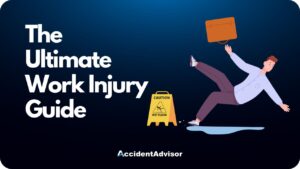Due to the severity of back injuries, workers’ comp back injury settlements often pay between $20,000 and $40,000. The number could be greater depending on several factors, including the cost of your medical expenses, the cost of treating partial or permanent disability, retraining expenses, or potential death benefits if the injury proved to be fatal.
If you or a loved one has suffered a back injury at work, you could be entitled to workers’ compensation. However, whether your claim is approved depends on how the compensation is calculated, the evidence linking the injury to your work activities, and how you responded following the accident.
Contact an experienced workers’ comp attorney to see if you are eligible for compensation for your back injury and how you can file a successful case with your employer’s workers’ comp representatives.
Table of Contents
- How Common Are Back Injuries at Work?
- What is the Average Workers Comp Back Injury Settlement?
- How to Calculate Compensation for a Back Injury at Work?
- What Factors Can Impact a Workers’ Compensation Claim?
- How to Prove a Back Injury at Work?
- What Jobs Are Most Likely to Result in a Back Injury at Work?
- Common Treatments for Back Injuries at Work
- How to File a Workers’ Compensation Claim for a Back Injury at Work?
- How Can a Work Injury Lawyer Help?
- Conclusion
How Common Are Back Injuries at Work?
The Bureau of Labor Statistics reports that as many as 20% of all workplace injuries are back-related, with over a million workers requiring treatment for a work-related back injury every year.
The National Safety Council also reports that in 2020, 128,220 of these injuries required an average of 9 days off from work. These lost wages combined with the medical expenses and potential future care for partial or permanent disability make back injuries a well-known liability for workers’ comp attorneys.
The most common back injuries include sprains, tears, and strains of the muscles and ligaments that support the back, leading to bruising, pain, soreness, and possible contusions. Only 1.6% of back injuries at work resulted in a fracture, but these are the most expensive injuries to settle since they are the most likely to lead to disability.
The most common back injuries at work do not lead to life-altering disabilities, but a strain can still cause significant medical expenses and lost wages, depending on the worker’s job and the nature of the injury.
What is the Average Workers Comp Back Injury Settlement?
The average workers’ comp back injury settlement is around $25,000, though this number could be as high as $80,000 for more severe injuries. Importantly, a back injury at work will rarely settle for as much as one sustained in a car crash or a slip and fall accident, which can settle for hundreds of thousands or even millions of dollars.
The reason is that workers’ comp does not settle with workers for their pain and suffering. It only pays the monetary expenses of managing the injury, including medical expenses, medication costs, lost wages, retraining expenses, and therapy costs.
Workers’ comp cases do not have to prove fault or the employer’s negligence to reach a settlement since employers pay for coverage in case of an injury like this. If you believe that your workers’ comp back injury settlement was too low or it was denied altogether, you can work-related personal injury lawsuit against your employer to receive compensation for your injuries.
However, while workers’ comp cases do not put your job at risk or sacrifice your other work-related benefits, a personal injury suit would. Speak with a workers’ comp attorney to learn which option is the best move for you.
How to Calculate Compensation for a Back Injury at Work?
Workers’ comp back injury settlements are calculated based on the medical costs, both present and future, that you have to pay related to your injury. Since workers’ comp settlements often pay as a lump sum, it’s important to calculate the damages accurately so that you aren’t shortchanged out of your future expenses.
Remember to include all medical expenses in your calculation, not just those that you sustained at the time. These include hospital bills, ambulance rides, prescription costs, testing costs, therapy costs, copays, and surgery costs. Your calculation should include lost wages, both those that you have already lost and those that you are predicted to miss in the future. If you have developed a disability or lost function in some way, this is called “specific loss” and should also factor into your settlement calculation.
Workers’ comp only settles economic damages, but a doctor’s diagnosis could go a long way to proving that you will be forced to pay future economic damages due to your injuries. This is why medical evidence is one of the key factors in having your calculations approved by the workers’ comp attorneys.
What Factors Can Impact a Workers’ Compensation Claim?
The severity of the injury, the evidence that supports its connection to your work, and your medical prognosis are key factors in determining your workers’ comp back injury settlement. These factors should support your calculations for medical expenses and lost income, including whether you will ever be able to work at your job again due to your injuries.
Workers’ comp attorneys consider the type of injury due to its implications for future care. A back injury that causes a spinal fracture or damages a nerve more easily justifies future medical expenses than a strain, which can often heal on its own with conservative treatments and time off.
The worse your diagnosis, the higher your calculations for compensation should be. While workers’ comp does not calculate pain and suffering, your reduced quality of life could factor into your compensation in other ways. For example, if you pay therapy bills because of new depression since the accident or have to switch jobs because your current one has become painful for you, you could include the financial aspect of these costs in your settlement amount.
Of course, claiming compensation for your back injury at work and having that workers’ comp settlement approved are two different things. You not only have to make a compensation case but prove it as well.
How to Prove a Back Injury at Work?
To prove a back injury at work, you need to document the incident as much as possible and collect as much proof of your medical expenditures as you can.
This starts immediately after the accident when you should take photos and videos of the scene (if you are able), collect contact information from witnesses, and accept medical care from on-site personnel. Refusal to accept medical attention could be perceived by your employers’ adjusters as a reason to reduce or deny your settlement.
You should also receive outside medical attention as soon as possible from either an emergency room or your primary physician. Tell them about your work and the conditions that caused your accident so they can diagnose your injury as work-related. These notes will be important evidence in your workers’ comp back injury settlement.
Importantly, not all back injuries at work are caused by an accident. Some are conditions resulting from chronic injuries caused by repetitive motions. These are much more difficult to prove since your work may not be the only contributing factor.
What Jobs Are Most Likely to Result in a Back Injury at Work?
The industries most susceptible to resulting in a back injury at work are those that involve lifting and carrying. According to the NSC, nearly 75% of work-related back injuries involve overexertion.
This gives the transportation, moving, and healthcare industries the most significant share of back injuries at work. After these, utilities installation and maintenance, repair, construction, and extraction industries are next. Back injuries can also result from office-related jobs such as sales, administration, management, and finance, though these are more often chronic illnesses as opposed to accidents.
The highest settlements in back injury workers’ comp cases are from industries where furniture, vehicle parts, healthcare equipment, construction materials, machinery, and other heavy things have to be lifted.
Common Treatments for Back Injuries at Work
The treatment for a back injury at work depends on the nature and severity of the injury, ranging from conservative treatments like rest to invasive surgery.
If you sustain a back injury at work, you will be tested for the nature and severity of the injury. A physical exam is possible in less severe cases, where a healthcare provider will ask you to sit, walk, stand, and move your legs to assess your movement ability. You may be given a pain reference sheet and asked to rate it based on daily activities.
Next, you may undergo tests such as an X-ray, MRI, CT scan, or nerve study. Based on these results, your doctor will prescribe the nature of your treatment. They may prescribe pain relievers like ibuprofen or other NSAIDs, muscle relaxers, opioids, or antidepressants.
Beyond that, cortisone injections, nerve stimulator implants, and other more invasive treatments are possible depending on the injury you sustained.
On average, back injuries leave people out of work for 9 days. However, this varies drastically from case to case as some injuries prevent workers from ever returning to their job again.
How to File a Workers’ Compensation Claim for a Back Injury at Work?
To file a workers’ compensation claim for a back injury, you should seek treatment immediately, document the site of the incident as detailed above, and speak with a workers’ comp attorney.
Your employer files with the insurance company first, so your first action should be to report the injury to your supervisor. From this point, you need to be careful what you say and refrain from posting about the incident online since anything you can say can be used against your claim.
To assemble the right medical documents, receipts, reports, and more, including a copy of your employer’s safety procedures and any witness testimonies, speak with an experienced attorney. You may also want to file a personal injury case if your workers’ compensation is insufficient or denied.
How Can a Work Injury Lawyer Help?
A work injury lawyer can help you prove your case for compensation to your employers’ workers’ comp adjusters by assembling the right evidence, coaching you on what to say and when, and filing on time.
States list their unique statutes of limitations for work-related injury reporting, some differing between chronic and acute injuries but most settling around 2 years from the date of the accident or diagnosis. Filing within this timeline is important to your case.
Finally, remember that the insurance adjuster and your employer’s attorneys are not your friends. Only an experienced work injury lawyer will be on your side as you try to win compensation for your work-related back injury.
Conclusion
Back injuries constitute a large portion of work-related injuries, with the most severe requiring years of medical treatment and potential reassignment. Workers’ comp pays for monetary damages related to your injury, but not all compensation claims are accepted. To prove your case and receive the settlement you deserve, contact an experienced workers’ comp attorney to review your options and file a winning case.

Rocky Horton
Author
Rocky Horton is a health and safety expert from Chapel Hill, NC. He is the founder of AccidentAdvisor and has been featured in Forbes, Bloomberg, and other publications. Learn more.













